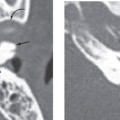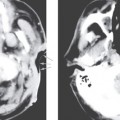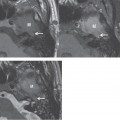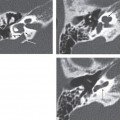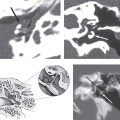CHAPTER 6 External Auditory Canal Atresia and Stenosis
Epidemiology
External auditory canal (EAC) dysplasia includes malformations of the external ear (pinna) and EAC. Because the development of the external and middle ear are closely linked, significant malformations of the EAC are usually associated with middle ear abnormalities. Due to the differences in development, inner ear anomalies are less commonly associated, though they are more frequent than in the general population. Congenital aural dysplasia (CAD) is estimated to occur in 1 in 3300 to 1 in 10,000 births and is often an isolated anomaly without a known cause. CAD is unilateral in 70% of cases and is slightly more common in males than females (60% versus 40%). When unilateral, the right ear is more commonly affected than the left. The majority of cases are sporadic, although 14% of cases are familial. CAD can also be associated with genetic disorders, chromosomal aberrations, intrauterine infections, and teratogens.
Embryology
Congenital aural dysplasia results from anomalous development of the first branchial groove. The first branchial groove deepens in the eighth week of gestation to form the lateral third of the EAC. The medial two thirds of the EAC develop from the meatal plate, which is a solid cord of epithelial cells extending from the lateral third of the EAC to the precursor of the middle ear cavity (pharyngeal pouch endoderm). Normally, the meatal plate begins to canalize between the 21st and 26th weeks of gestation. Failure of canalization of the meatal plate results in congenital aural atresia (CAA). Because the first and second branchial pouches and first pharyngeal pouches develop simultaneously, CAA is often associated with anomalies of the middle ear and mastoid.
Clinical Features
Discovery of CAA in a newborn is a cause of great anxiety for the parents, especially when associated with cutaneous manifestations. Patients with CAA are diagnosed early in life and present with a deformity of the auricle and no visible auditory canal. The majority of cases of CAA are sporadic; however, CAA has been associated with various disorders, including Treacher Collins syndrome, Crouzon disease, Klippel-Feil syndrome, Möbius syndrome, Duane syndrome, VATER (vertebral defects, imperforate anus, tracheoesophageal fistula, and radial and renal dysplasia) association, CHARGE (coloboma of the eye, heart anomaly, choanal atresia, retardation, and genital and ear anomalies) association, and Pierre Robin syndrome. Association with a systemic malformation is generally a negative prognostic indicator for successful corrective surgery.
Stay updated, free articles. Join our Telegram channel

Full access? Get Clinical Tree


